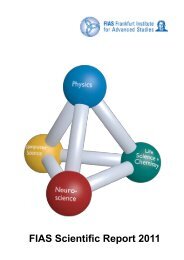FIAS Scientific Report 2010 - Frankfurt Institute for Advanced Studies ...
FIAS Scientific Report 2010 - Frankfurt Institute for Advanced Studies ...
FIAS Scientific Report 2010 - Frankfurt Institute for Advanced Studies ...
Create successful ePaper yourself
Turn your PDF publications into a flip-book with our unique Google optimized e-Paper software.
Possibility of synthesizing superheavy elements in nuclear explosions<br />
Collaborators: I.N. Mishustin 1 , W. Greiner 1 , A. Botvina 1,2 , V. Zagrebaev 1,3<br />
1 <strong>Frankfurt</strong> <strong>Institute</strong> <strong>for</strong> <strong>Advanced</strong> <strong>Studies</strong>, 2 <strong>Institute</strong> <strong>for</strong> Nuclear Research, RAS, Moscow, 3 Joint <strong>Institute</strong> of Nuclear<br />
Research, Dubna<br />
We study the possibility of synthesizing heavy and superheavy elements by using intensive neutron fluxes<br />
generated by nuclear explosions. Actually, this method was already partially employed alongside with nuclear<br />
reactors. However, because of some technical and political constraints it was abandoned later. Nevertheless, this<br />
method provides the highest neutron densities which are not possible to reach with other terrestrial techniques.<br />
The typical fusion reactions like 238 U + 48 Ca lead to proton-rich compound nuclei which lie above the βstability<br />
line. On the other hand, the multiple neutron-capture reactions in nuclear explosions may bring the<br />
238 U nuclei to the neutron drip-line. Then, after the neutron flux ceased, these nuclei undergo multiple β-decay<br />
and come close to the island of stability from the neutron-rich side. If a single explosion is insufficient, then, in<br />
principle, a properly delayed second explosion can do the job.<br />
ρ(A n )/ρ 0<br />
constant neutron density<br />
0.1μs<br />
0.3μs<br />
1μs<br />
ρ n =4*10 22 cm -3<br />
T=10 keV<br />
238 U<br />
3μs<br />
number of absorbed neutrons<br />
Relative abundances of neutron-rich nuclei produced after capture of neutrons normalized to the initial number of 238 U<br />
nuclei. It is assumed that a 238 U target is irradiated by a constant neutron flux of about 7·10 30 n/(s·cm 2 ) corresponding to<br />
neutron density and temperature given in the figure. Calculations are done <strong>for</strong> different exposure times (in microseconds)<br />
indicated at the corresponding curves.<br />
Related publications in <strong>2010</strong>:<br />
1. Alexander Botvina, Igor Mishustin, Valeri Zagrebaev and Walter Greiner, Possibility of synthesizing<br />
superheavy elements in nuclear explosions, Int. J. Mod. Phys. 19,2063-2075 (<strong>2010</strong>);<br />
2. Igor Mishustin, Production of heavy and superheavy nuclei in explosive processes, invited talk at the<br />
International Symposium “Advances of Nuclear Physics in Our Time” (Goa, India, Nov. 28 - Dec. 2,<br />
<strong>2010</strong>), to be published in Proceedings.<br />
42

















